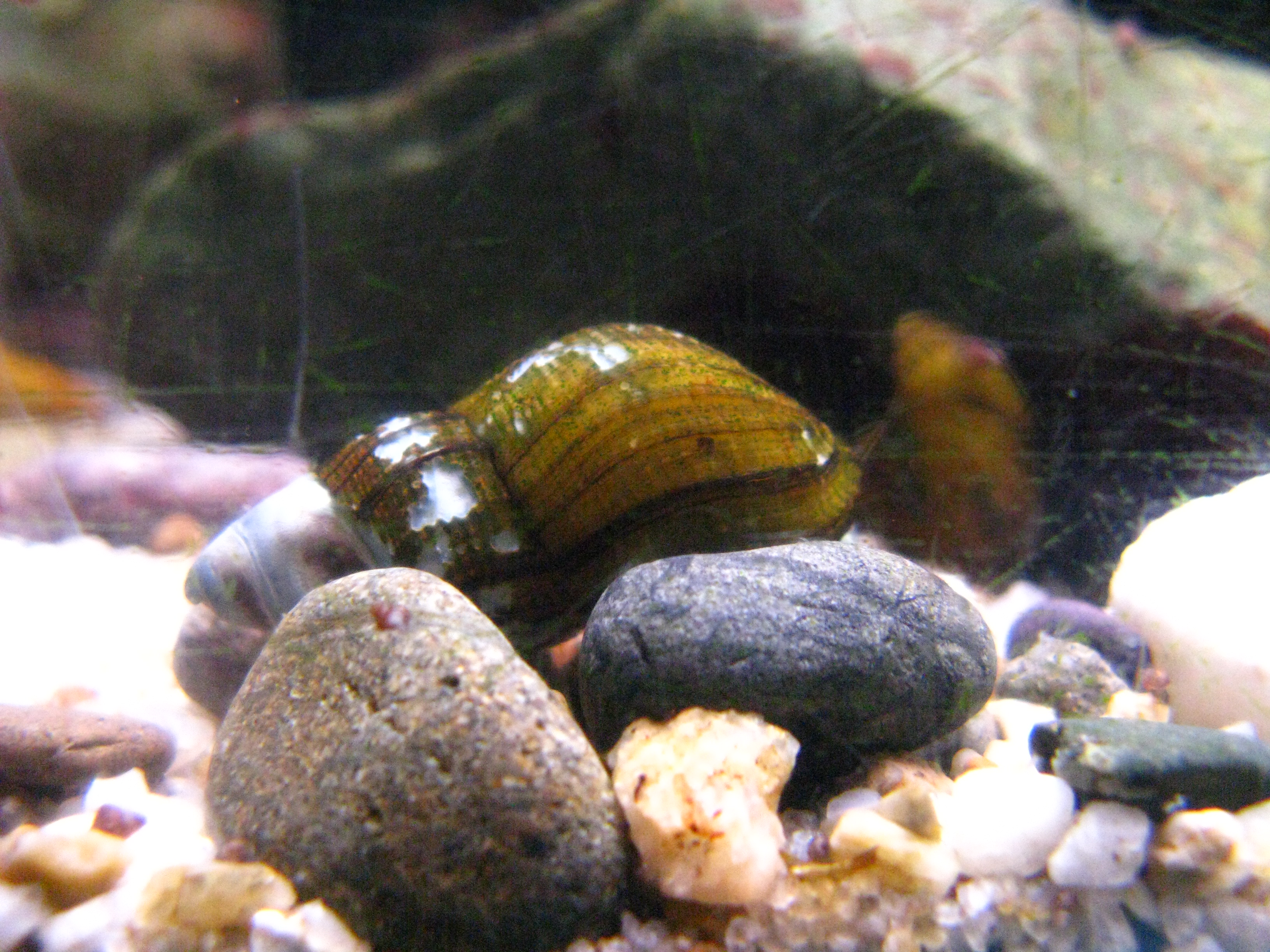Semisulcospira kurodai on:
[Wikipedia]
[Google]
[Amazon]
''Semisulcospira kurodai'' is a 
211
294.
CiNii
One female can give life to 62 to 79 newborn snails in the laboratory. Takami A. (1995). "室内飼育におけるクロダカワニナの成長と産仔数 rowth and Number of Newborns in ''Semisulcospira kurodai'' (Prosobranchia: Pleuroceridae) Reared in the Laboratory. ''Venus'' 54(2): 123-132
CiNii
The average size of the shell of a newborn snail varies according to the locality from in width and from in height of the shell. ''Semisulcospira kurodai'' can live up to four years in the laboratory.
CiNii
* Oniwa K. & Kimura M. (1986). "Genetic variability and relationships in six snail species of the genus ''Semisulcospira''". ''The Japanese journal of genetics'' 61(5): 503-514
CiNii
* Takami A. (1995). "31. クロダカワニナの産仔数, 新生貝の大きさと成長(平成 6 年度大会(豊橋)研究発表要旨) 1. Number, size and growth of newborns in ''Semisulcospira kurodai'' under the laboratory conditions (Abstracts of Papers Presented at the 1995 Annual Meeting in Toyohashi City). ''Venus'' 54(1): 96
CiNii
* Takami A. (1991). "カワニナ属 3 種の産仔頻度, 産仔数と新生貝の大きさ he Birth Frequency, Number and Size of Newborns in the Three Species of the Genus ''Semisulcospira'' (Prosobranchia: Pleuroceridae). ''Venus'' 50(3): 218-232
CiNii
species
In biology, a species is the basic unit of classification and a taxonomic rank of an organism, as well as a unit of biodiversity. A species is often defined as the largest group of organisms in which any two individuals of the appropriate s ...
of freshwater snail
Freshwater snails are gastropod mollusks which live in fresh water. There are many different families. They are found throughout the world in various habitats, ranging from ephemeral pools to the largest lakes, and from small seeps and springs ...
with an operculum, an aquatic gastropod
The gastropods (), commonly known as snails and slugs, belong to a large taxonomic class of invertebrates within the phylum Mollusca called Gastropoda ().
This class comprises snails and slugs from saltwater, from freshwater, and from land. T ...
mollusk
Mollusca is the second-largest phylum of invertebrate animals after the Arthropoda, the members of which are known as molluscs or mollusks (). Around 85,000 extant species of molluscs are recognized. The number of fossil species is e ...
in the family Semisulcospiridae
Semisulcospiridae, common name semisulcospirids, is a family of freshwater snails, aquatic gilled gastropod mollusks with an operculum, in the superfamily Cerithioidea. MolluscaBase eds. (2021). MolluscaBase. Semisulcospiridae J. P. E. Morri ...
. Prior to 2009, this species was classified in the family Pleuroceridae
Pleuroceridae, common name pleurocerids, is a family of small to medium-sized freshwater snails, aquatic gilled gastropod mollusks in the superfamily Cerithioidea.These snails have an operculum and typically a robust high-spired shell.
Reprodu ...
.

Distribution
This species occurs inJapan
Japan ( ja, 日本, or , and formally , ''Nihonkoku'') is an island country in East Asia. It is situated in the northwest Pacific Ocean, and is bordered on the west by the Sea of Japan, while extending from the Sea of Okhotsk in the north ...
.
Description
The maximum width of the shell of ''Semisulcospira kurodai'' is and in height in the laboratory. The maximum weight of the animal is in the laboratory. The width of the shell is in the first year, in the second year, in the third year and in the fourth year in the laboratory. The diploidchromosome number
Ploidy () is the number of complete sets of chromosomes in a cell, and hence the number of possible alleles for autosomal and pseudoautosomal genes. Sets of chromosomes refer to the number of maternal and paternal chromosome copies, respectivel ...
of ''Semisulcospira kurodai'' is 2n=35 and 2n=36 (both chromosome numbers were observed).Davis G. M. (1969). "A taxonomic study of some species of ''Semisulcospira'' in Japan (Mesogastropoda: Pleuroceridae)". ''Malacologia
''Malacologia'' is a peer-reviewed scientific journal in the field of malacology, the study of mollusks. The journal publishes articles in the fields of molluscan systematics, ecology, population ecology, genetics, molecular genetics, evolu ...
'' 7211
294.
Ecology
Habitat
''Semisulcospira kurodai'' lives in rivers and in ponds.Life cycle
The female has 17 to 72 embryos in its brood pouch. Takami A. (1997). "クロダカワニナの分布と成貝および新生貝の種内変異 istribution and Intraspecific Variation in Adult and Newborn Shells of ''Semisulcospira kurodai'' (Prosobranchia: Pleuroceridae). ''Venus'' 56(4): 305-317CiNii
One female can give life to 62 to 79 newborn snails in the laboratory. Takami A. (1995). "室内飼育におけるクロダカワニナの成長と産仔数 rowth and Number of Newborns in ''Semisulcospira kurodai'' (Prosobranchia: Pleuroceridae) Reared in the Laboratory. ''Venus'' 54(2): 123-132
CiNii
The average size of the shell of a newborn snail varies according to the locality from in width and from in height of the shell. ''Semisulcospira kurodai'' can live up to four years in the laboratory.
References
Further reading
* Goto T. (1994). "岐阜県のクロダカワニナ 'Semisulcospira kurodai'' Kajiyama & Habe in Gifu Prefecture. ちりぼたん ''The Chiribotan'' 24(3-4): 100-101CiNii
* Oniwa K. & Kimura M. (1986). "Genetic variability and relationships in six snail species of the genus ''Semisulcospira''". ''The Japanese journal of genetics'' 61(5): 503-514
CiNii
* Takami A. (1995). "31. クロダカワニナの産仔数, 新生貝の大きさと成長(平成 6 年度大会(豊橋)研究発表要旨) 1. Number, size and growth of newborns in ''Semisulcospira kurodai'' under the laboratory conditions (Abstracts of Papers Presented at the 1995 Annual Meeting in Toyohashi City). ''Venus'' 54(1): 96
CiNii
* Takami A. (1991). "カワニナ属 3 種の産仔頻度, 産仔数と新生貝の大きさ he Birth Frequency, Number and Size of Newborns in the Three Species of the Genus ''Semisulcospira'' (Prosobranchia: Pleuroceridae). ''Venus'' 50(3): 218-232
CiNii
External links
{{Taxonbar, from=Q7449669 Semisulcospiridae